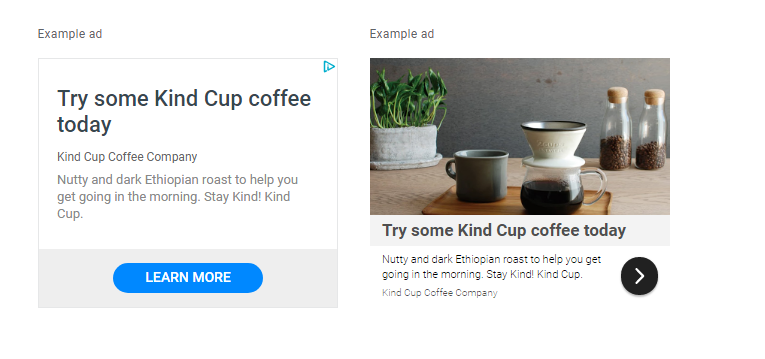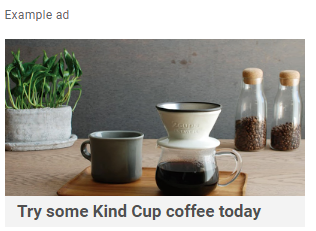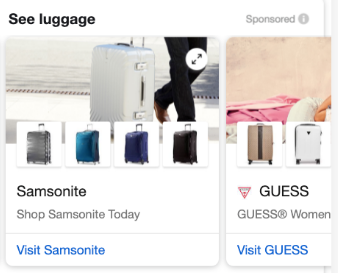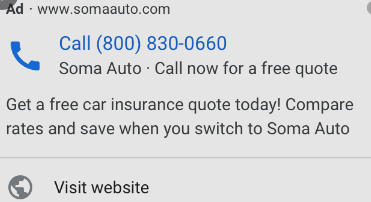What are Google Ads?

Google Ads have sponsored adverts that display on Google’s search engine results page (SERP). The Google Adsense programme or display network is used to display these ads.
The Google Display Network consists of a large number of third-party websites that have joined with Google to display Google Ads. These websites’ display network adverts appear in specific regions. Above is an example of a Google Ad that appears above the organic search results on Google’s SERP.
How to Set Up Google Ads?

Here are some Google Ads tips that will help you get started with your campaign:
Understand a few basic terms to get started with
- Keywords: words or phrases that people use to search the internet. When creating an ad campaign, you’ll need to come up with a list of keywords that you believe your target demographic uses frequently.
- Bid: When someone clicks on your ad, your bid is the utmost amount you’re willing to spend.
- Quality Score: This score determines how relevant your keywords are to your advertisements. A high quality score will reduce your bid cost and help your ad rank higher in the SERPs.
- Ad Rank: When compared to other advertising, this parameter helps determine whether your ad will appear when activated on Google.
- Cost Per Click: When someone clicks on your ad, you pay a cost per click.
- Conversion: A conversion occurs when someone clicks on your ad and then completes another action on your website, such as signing up for a newsletter or making a purchase.
1. Get your account organized
When it comes to operating a successful ad campaign, segregation is crucial. Break down your products or services into categories to begin.
Within a Google Ads account, there are two layers of organisation: campaigns and groups. Campaigns represent your company’s broad categories, whereas groups represent a more focused set of items or services.
To make things clearer, consider the following example:
- Campaign: Cakes
- Ad Group 1: Chocolate Cake
- Ad Group 2: Pineapple Cake
- Ad Group 3: Vanilla Cake
2. Set your budget
You may restrict your spending limit in Google Ads using two different settings: bids and daily budget.
Your bid is the amount you’re willing to spend when someone clicks on your ad, and your budget is the total amount you want to spend on each campaign every day.
If you’re new to Google Ads, it’s a smart idea to spread your daily budget over all of your ads. You can later adjust the budget based on the results of the best-performing campaigns.
3. Pick your keywords
The Keyword Planner is a free service provided by Google that allows you to produce a list of keywords for your ad campaigns.
The tool also assists you in determining how much to pay for a specific keyword in order for it to appear in the search results.
In general, more competitive keywords have a higher bid amount, so if you’re just getting started with Google Ads, it’s a good idea to stick to low and medium competition keywords.
4. Set your keyword match type

The Keyword Planner is a free service provided by Google that allows you to produce a list of keywords for your ad campaigns.
The tool also assists you in determining how much to pay for a specific keyword in order for it to appear in the search results.
In general, more competitive keywords have a higher bid amount, so if you’re just getting started with Google Ads, it’s a good idea to stick to low and medium competition keywords.
On Google Ads, you have five keyword match types to choose from:
Broad Match: For Google Ads, the broad match setting is the default. It displays advertisements for searches that include your target keyword in any order, as well as similar terms.
Broad Match Modifier: A broad match modifier allows you to specify which terms from your key should be in a user’s search query in order for your ad to display.
Phrase Match: Using this option, you can appear in searches that include your exact keyword or key phrase, as well as other words before or after your keyword.
Exact Match: If you use an exact match query, your ad will appear when a user types in the exact keyword you’re targeting in your ad.
Negative Match: This option allows you to avoid certain search phrases from displaying in your adverts.
5. Set your landing pages
Select your landing page carefully. People will be sent to a landing page on your website when they click on your ad.
Rather than redirect visitors to your home page, you can route them to a landing page with material connected to your ad.
6. Decide which devices to show up for
You’ll have to pick whether you want your ads to appear on mobile devices, desktop computers, or both, depending on the type of your business. If you run a mobile game company, for example, it makes sense to promote exclusively on mobile devices.
7. Write your ads
Your ad copy has the power to make or destroy your campaign, so make sure it’s relevant, clear, and has a strong call-to-action.
Later in this article, you’ll learn how to write an advertisement.
8. Connect your ads account to Google Analytics
Google Analytics provides you with a more in-depth understanding of how consumers engage with your ads and website.
You can monitor how viewers act when they arrive at your site, how long they stay on your site, and other key indicators that can help you better strategize your ad campaigns by integrating Analytics.
9. Activate and keep checking back.
Activate your campaign and monitor its progress on a regular basis. You’ll have a better sense of your best-performing campaigns over time and spend your ad budget wisely.
Top Reasons to Advertise on Google Ads

If you haven’t tried Google Ads yet and aren’t sure if it’s worth it, here are some of the finest reasons to do so.
Google Ads are scalable
Because Google Ads are scalable, you won’t have to double your work to double your leads.
If your Google ad campaign is profitable, you can gradually increase your PPC budget in order to boost your leads and revenues.
Google Ads are measurable
Google Ads is a very measurable form of online advertising. It gives you a variety of PPC indicators to assist you evaluate how your ad campaigns are doing and whether you’re receiving a good return on investment.
Google Ads are flexible
Google Ads can be tailored to meet your exact requirements. For example, you may utilise ad extensions to edit your advertising and select the keyword match type for your ad campaigns. You can also filter down your target depending on their location, language, and interests.
Google Ads are faster than SEO
SEO is a long-term process that takes time to bear fruit. This is particularly true for newly launched websites. Google Ads, on the other hand, may be a viable option to examine if you want to make it quick.
You won’t have to wait long to see noticeable results with Google Ads because you’ll start earning impressions and clicks as soon as your campaign goes live.
Google Ads are ruling the SERPs
Google Advertisements generates more than 95% of the company’s revenue, which is why the company is increasing the exposure of its ads above the fold while pushing organic results down.
While trying to rank a website organically might be frustrating, investing in PPC to increase traffic isn’t a bad idea either.
Google Ads format can be more engaging and might convert better
Google Ads exist in a variety of media, including videos, photos, text, and more, and they look to be more interesting than organic SERP results.
This can significantly increase ad CTR and lead to higher conversions than organic results. Because paid search is so specific, the chances of converting the audience are much higher.
Google has a massive reach
Another reason to utilise Google Ads is the company’s immense popularity and reach, which makes it one of the world’s most trusted search engines.
It is also the most popular search engine in the world, with a market share of 75%.
Your competitors are using Google Ads
Finally, the majority of your competitors are most likely utilising Google Ads, so why should you?
All of the aforementioned advantages of using Google Ads make it the number one choice for most businesses looking to dominate the online game.
Types of Google Ads Formats

In your Google Ads account, you can employ a variety of ad formats, such as:
Text Ads

Text ads are the most prevalent ad format because they just contain text.
Responsive Ads

Ads that are responsive modify their size, style, and format to fit the space available.
Image Ads

Ads in image formats such as gifs or flash can be static or dynamic.
App Promotion Ads

App promotion ads aid in increasing app download engagement.
Video Ads
Advertising that run in video format are known as video ads.
Product Shopping Ads

Users see an image of your product together with other important facts such as its price, name, and store name in shopping advertising.
Showcase Shopping Ads

When you click on an image in a showcase shopping ad, it expands to show you numerous related products.
Call-Only Ads

The title and phone number for people to contact the business are included in call-only adverts.
What is Google Ad Copy?
The text of a Google ad copy is produced to entice customers to click on the ad and purchase a product or service. A smart Google ad copy can increase click-through rates and conversions.
Guidelines to Write Successful Google Ads Copy
Here are some tips for developing effective Google Ads copy:
1. Get into the minds of the buyers
Ask yourself what your target audience is looking for before you start crafting your ad copy. Before you write the copy, think about what they want.
An ad content that resonates with your target audience and offers to address their problems will gain the attention it deserves right away.
2. Include a Call to Action
Every advertisement must have a call to action. Your target audience won’t be able to figure out what you want them to do if they click on your ad if it doesn’t have it.
semrush.com is the source for this information.
Furthermore, CTAs aid in capturing the audience’s attention and encouraging them to click on the ad.
3. Make your ad mobile-friendly
Because the bulk of your target audience uses mobile devices, you’ll need to make sure the landing page where they go after clicking on the Google ad is mobile-friendly.
4. Include special offers
Remember to include any special discounts or offers that are currently running on your website in your ad copy to make it more eye-catching. When people buy a product or service from a website, they adore getting these extra benefits.
5. Match your landing page to the theme of the ad
The biggest blunder you can do is to deceive your customers with your advertisements. When you run a Google ad, make sure the landing page matches the ad’s theme.
6. Keep it simple
Maintain a simple yet engaging ad copy. Avoid using difficult-to-understand terminology, acronyms, and difficult-to-understand language.
7. Highlight your USPs
Highlight your unique selling propositions if you want to stand out from the crowd. Mention the features that set you apart from your competitors. Your target audience will be drawn to your business as a result of this.
8. Add keywords to your ads smartly
Add your major keyword to the ad title and copy to increase the reach of your Google ad. This will ensure that your advertisement reaches the intended target.
9. Include emotional triggers
Using emotional triggers in particular ad categories works wonders. If you’re selling a weight-loss product, for example, you can utilise an emotional trigger in your text to speak directly to those who are struggling to lose weight.
10. Experiment with multiple copies
Don’t limit yourself to one form of a Google ad copy while writing it. Write a few different versions of your ad and discuss them with your team to choose the best one.
11. Create a sense of urgency
Create a sense of urgency in your ad copy, such as promoting a limited-time deal or discount, if you want your target audience to notice your Google Ads. This will aid in increasing the number of clicks.
12. Use ad extensions
Increase your ad’s click-through rate by including more information in your ad, such as your office address, phone number, and so on, using ad extensions. People are more inclined to act if they can get all the information they need immediately from your ad.
13. Address your target audience directly.
Making your ad copy more personal by directly addressing your target audience will help you increase engagement. Using terms like “you” and “your” in your text sends a strong message to your audience and gives them the impression that you are speaking directly to them.
14. Keep experimenting
You’ll have to experiment with various aspects of your Google ad, in addition to the ad copy, to make it more effective. This includes the title of your ad, the call to action, and any images or videos you use in your Google ad.
Best Google Ads Examples
Here are the top three best Google Ads examples, along with the main qualities that set them apart from the competition.
Characteristics:
- Services that are well defined
- It helps to build trust.
- USPs are highlighted.
Characteristics:
- The cost was mentioned.
- Highlighted Offers
- Features that are clearly stated
Conclusion
Google Ads are incredibly efficient at generating targeted visitors to your website and increasing product or service sales. If you want to get the most out of your business, mix your organic SEO efforts with paid marketing methods such as PPC or Google Ads.